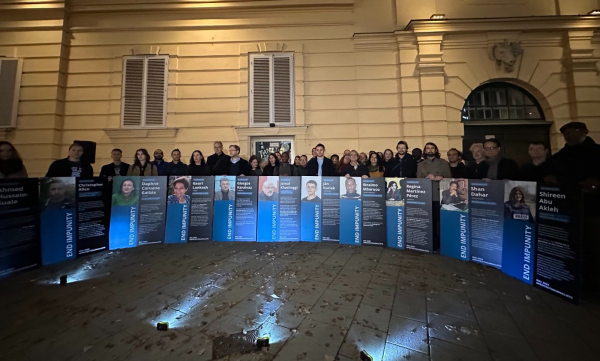British photographer Paul Conroy has reportedly been safely evacuated to Lebanon, while the whereabouts of French correspondent Edith Bouvier remain unconfirmed, nearly a week after the journalists were injured in an assault that killed Sunday Times correspondent Marie Colvin and photojournalist Remi Ochlik.
“We welcome the reported safe evacuation of Paul Conroy, but are deeply concerned about the well-being of Edith Bouvier, and note that the onslaught against civilians, including journalists, in Homs continues unabated,” said IPI Press Freedom Manager Anthony Mills. “The journalists, videographers and activists bearing witness to these events on behalf of the world continue to do so at enormous peril, despite apparent efforts to silence them by deliberately targeting them.”
Bouvier of French newspaper Le Figaro and British photojournalist Paul Conroy, who also worked for the Sunday Times, both received leg injuries – Bouvier suffered multiple bone fractures, while Conroy was hit by shrapnel. Both had sent video appeals calling for their evacuation for medical treatment from the Baba Amr district of Homs, where a bloody onslaught by the Syrian army has been underway since the beginning of the month.
Two efforts to evacuate the journalists, on Friday and Monday, failed when the pair refused to be picked up by the Syrian Arab Red Crescent, whose intentions may have appeared suspect, news reports say.
The International Committee of the Red Cross and other medical volunteers working in Homs have said that the many wounded are treated only in makeshift clinics that are not properly equipped or staffed, and have repeatedly called for a cease-fire so that the injured can be evacuated along with women and children, reports say. Those who have been hurt are reportedly scared to get help from hospitals, which they say have been taken over by the government.
Several journalists and citizen reporters who have provided information and footage to foreign media have fallen victim to the continuing slaughter. Videographer Anas Al-Tarsha, 17, was reportedly killed when a mortar shell hit him as he was filming in Homs last Friday, reports say. With foreign journalists largely prevented from reporting independently in Syria, news media have relied heavily on citizen reporters and activists documenting the violence.
Al-Tarsha is the seventh journalist to have been killed in Syria in 2012 according to the IPI Death Watch, making Syria by far the deadliest country for journalists in the world so far this year. The others include Colvin, Ochlik, Rami Al-Sayed, Mazhar Tayyara, Gilles Jacquier and Shukri Abu el-Burghol. An eighth, New York Times correspondent Anthony Shadid, died of an asthma attack while crossing the Turkish-Syrian border earlier this month.
IPI continues to call for the release of Mazen Darwish and nine others who were arrested by Syria’s Air Force Intelligence services during a raid on the Syrian Centre for Media and Freedom of Expression (SCM) in Damascus on Feb. 16, 2011. Sixteen journalists, activists and visitors to the offices were originally arrested, but six have subsequently been released on the condition that they check in with the authorities each morning. Those who remain in prison are believed to be at risk of torture.


